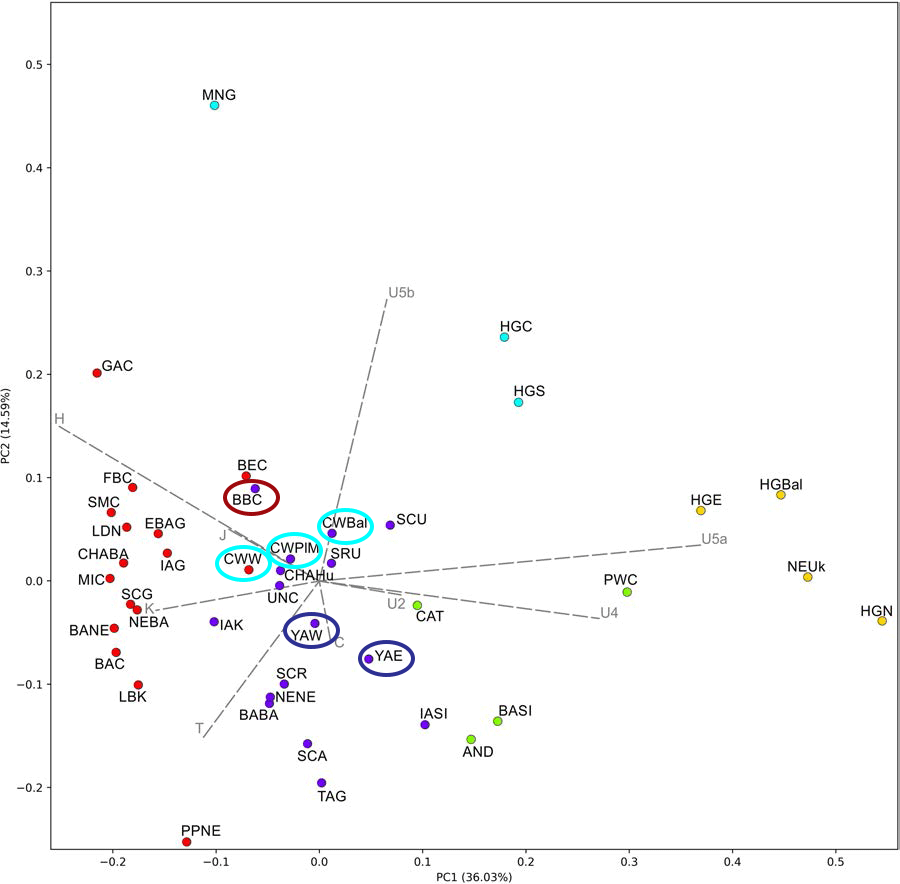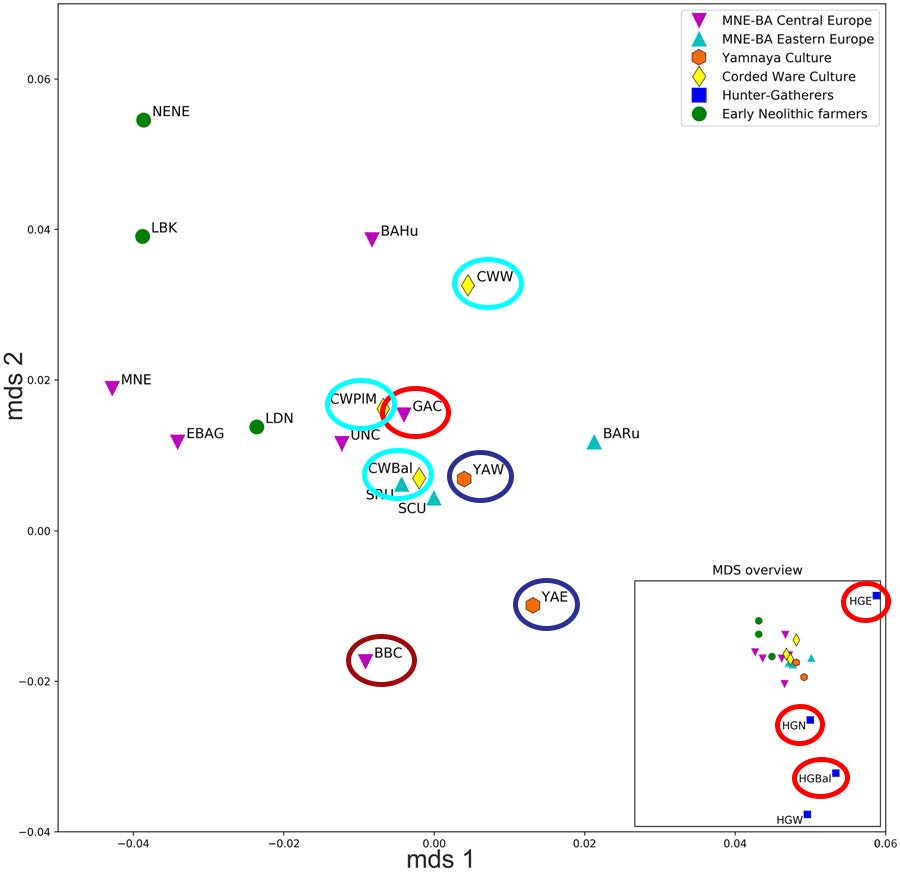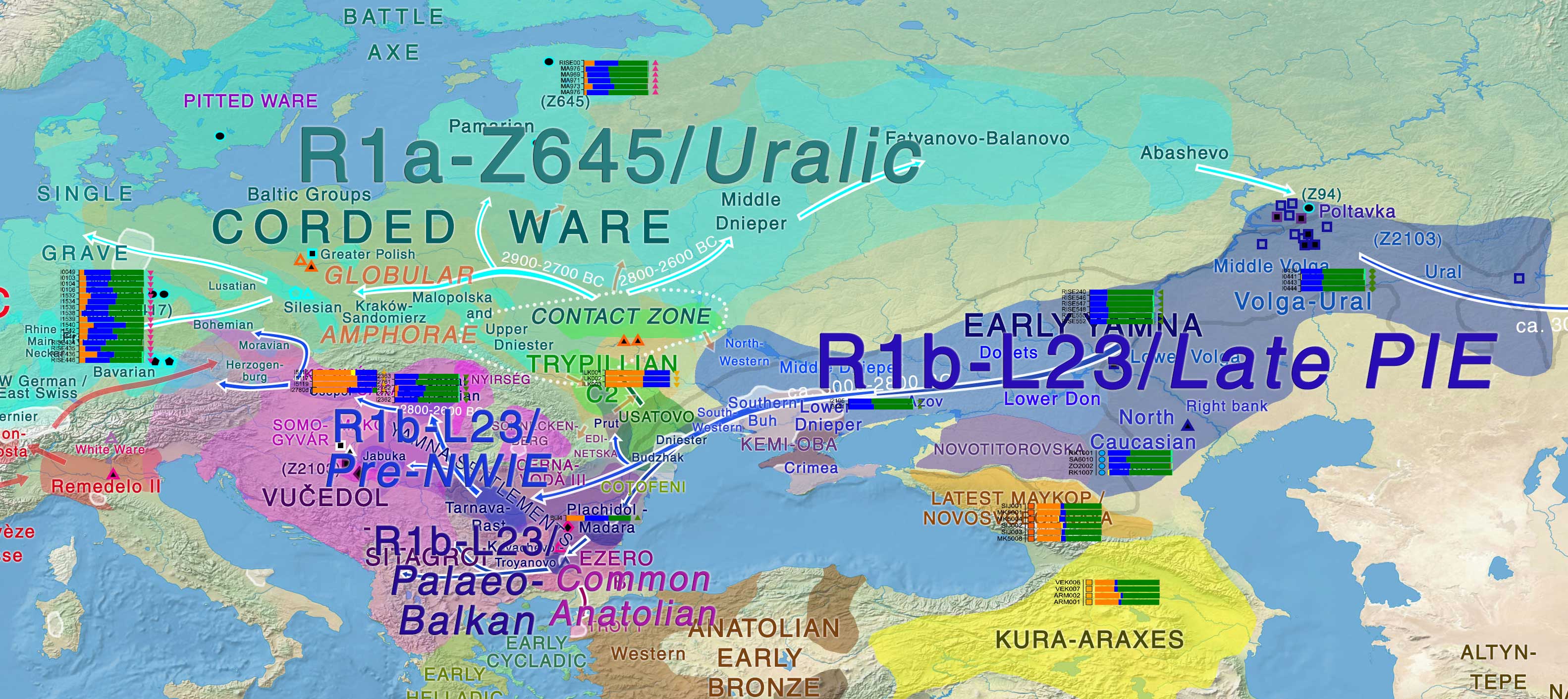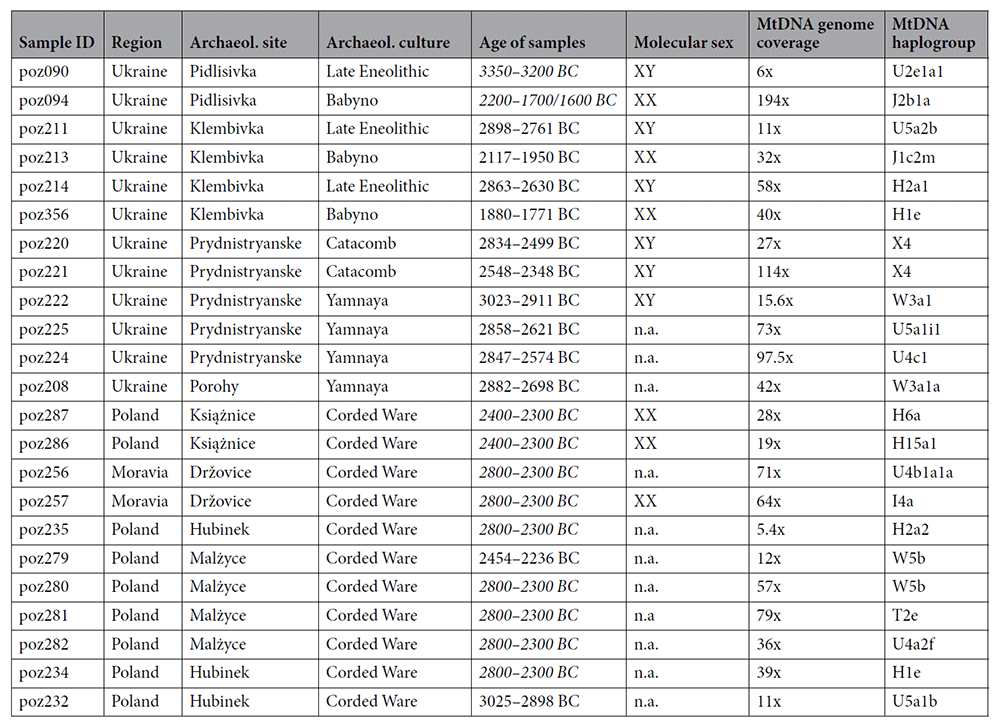Open Access Mitochondrial genomes reveal an east to west cline of steppe ancestry in Corded Ware populations, by Juras et al., Scientific Reports (2018) 8:11603.
Interesting excerpts (emphasis mine, references have been deleted for clarity):
Ancient DNA was extracted from the Corded Ware culture individuals excavated in southeastern Poland (N = 12) and Moravia (N = 3). Late Eneolithic (N = 5) and Bronze Age human remains (N = 25) originated from western Ukraine and came from the Yampil barrow cemetery complex located in the north–western region of the Black Sea. Bronze Age individuals were associated with different archaeological cultures, including Yamnaya (N = 14), Catacomb (N = 2), Babyno (N = 4) and Noua (N = 5).
The PCA results described 50.62% of the variability and were combined with the k-means clustering (with the k value of 5 as the best representation of the data, at the average silhouette of 0.2608). Based on these results individuals associated with the western and eastern Yamnaya horizon (YAE and YAW in Fig. 2) were grouped within a cluster consisting of populations from central Eurasia and Europe (blue cluster) including people associated with eastern Corded Ware culture (CWPlM) and Baltic Corded Ware culture (CWBal). This cluster did not contain any populations linked with early Neolithic farmers (red), or hunter-gatherers (green and yellow). On the other hand, k-means clustering linked the western Corded Ware culture-associated population (CWW) with Near East and Neolithic farmer ancestry groups from western and central Europe.

Pairwise mtDNA-based FST values, visualized on MDS using the raw non-linearized FST (stress value = 0.099) (Fig. 4), also supported the PCA results and indicated that western and eastern Yamnaya horizon groups (YAW and YAE) were closer to people associated with the eastern Corded Ware culture (CWPlM) (FST = 0.00; FST = 0.01, respectively; both p > 0.05) and Baltic Corded Ware culture (CWBal) (FST = 0.00; FST = 0.00, respectively; both p > 0.05), than to populations associated with the western Corded Ware culture (CWW) (FST = 0.047 and FST = 0.059, respectively; both statistically significant p < 0.05). Western and eastern Yamnaya horizon groups also showed close genetic affinity to the Iron Age western Scythians (SCU) (FST = 0.0022 and FST = 0.006, respectively, both p > 0.05). The most distant populations to the Yamnaya horizon groups were western hunter-gatherers (HGW) (FST = 0.23 and FST = 0.15, p < 0.001). The FST-based MDS reflected the general European population history in the post-LGM period as the three highest FST scores were detected between western hunter-gatherers (HGW) and people associated with Linear Pottery culture (LBK) (FST = 0.33, p < 0.001), between eastern hunter-gatherers (HGE) and Baltic hunter-gatherers (HGBal) (FST = 0.35, p < 0.05), and between western (HGW) and eastern hunter-gatherers (HGE) (FST = 0.36, p < 0.05). The Yamnaya horizon groups (YAE and YAW) were placed centrally between northern hunter-gatherers (HGN) and Neolithic farmers (LDN), in direct proximity to the Bronze and Iron Age populations from Eastern Europe (SCU, BARu, SRU) and close to individuals associated with eastern and Baltic Corded Ware culture.

Among the analyzed samples, we identified two Catacomb culture-associated individuals (poz220 and poz221) belonging to hg X4. They are the first ancient individuals assigned to this particular lineage. Haplogroup X4 is rare among present day populations and has been found only in one individual each from Central Europe, Balkans, Anatolia and Armenia.
Moreover, we have reported mtDNA haplotypes that might be associated with the migration from the steppe and point to genetic continuity in the north Pontic region from Bronze Age until the Iron Age. These haplotypes were assigned to hgs U5, U4, U2 and W3. MtDNA hgs U5a and U4, identified in this study among Yamnaya, Late Eneolithic and Corded Ware culture-associated individuals, have previously been found in high frequencies among northern and eastern hunter-gatherers. Moreover, they appeared in the north Pontic region in populations associated with Mesolithic (hg U5a), Eneolithic (Post-Stog) (hg U4), Yamnaya (hgs U5, U5a), Catacomb (hgs U5 and U5a) and Iron Age Scythians (hg U5a), suggesting genetic continuity of these particular mtDNA lineages in the Pontic region from, at least, the Bronze Age. Hgs U5a and U4-carrying populations were also present in the eastern steppe, along with individuals from the Yamnaya culture from Samara region, the Srubnaya and the Andronovo from Russia. Interestingly, hg U4c1 found in the Yamnaya individual (poz224) has so-far been found only in two Bell Beaker- associated individuals and one Late Bronze Age individual from Armenia, which might suggest a steppe origin for hg U4c1. A steppe origin can possibly also be assigned to hg U4a2f, found in one individual (poz282) but not reported in any other ancient populations to date, and to U5a1- the ancestral lineage of U5a1b, reported for individual poz232, which was identified not only in Corded Ware culture-associated population from central and eastern Europe, but also in representatives of Catacomb culture from the north Pontic region, Yamnaya from Bulgaria and Russia, Srubnaya and Andronovo-associated groups. Hg U2e, reported for Late Eneolithic individual (poz090), was also identified in western Corded Ware culture-associated individual and in succeeding Sintashta, Potapovka and Andronovo groups, suggesting possible genetic continuity of U2e1 in the western part of the north Pontic region.
Hgs W3a1 and W3a1a, found in two Yamnaya individuals from this study (poz208 and poz222), were also identified in Yamnaya-associated individuals from the Russia Samara region and later in Únětice and Bell Beaker groups from Germany, supporting the idea of an eastern European steppe origin of these haplotypes and their contribution to the Yamnaya migration toward the central Europe. The W3a1 lineage was not identified in Neolithic times and, thus, we assume that it appeared in the steppe region for the first time during the Bronze Age. Notably, hgs W1 and W5, which predate the Bronze Age in Europe, were found only in individuals associated with the early Neolithic farmers from Starčevo in Hungary (hg W5), early Neolithic farmers from Anatolia (hg W1-T119C), and from the Schöningen group (hg W1c) and Globular Amphora culture from Poland (hg W5).
Some comments
The most recent radiocarbon dates show that Early Yamna expanded to the west with Repin settlers of the Lower Don ca. 3350/3300 BC. At the end of the 4th millennium, then, these settlers dominated over groups whose population had in turn also elevated ‘steppe ancestry’ (at least from ca. 4000 BC, as shown by Ukraine Eneolithic samples from the forest-zone), and probably replaced the male population completely, as evidenced by other Yamna and Poltavka, and later Bell Beaker, Catacomb, and Sintashta samples.
The ‘second wave’ of expansion of Yamna settlers to the west, into east-central European steppes, began probably ca. 3100/3000 BC, and – based on material culture – stemmed mainly from the North Pontic area. The Yampil Barrow Complex on the Dnieper (which I recently wrote about) seems to be part of one of the groups of western Yamna migrants: those who migrated westward from the left bank of the Dniester to the west into the Prut-Siret region, and north along the Prut.
This region is the key for population movements that gave rise to the Corded Ware culture (see another recent post on Corded Ware origins). It is quite likely that we will see a dance of late Trypillia / Usatovo, GAC, (Proto-)Corded Ware, and Yamna samples in this area. Judging by the clear-cut Y-DNA bottlenecks we are seeing in Neolithic populations, especially among steppe pastoralists, the difference between groups in recovered ancient samples will not only be clear from their culture, but also from their male lineages.
Based on the number of burials studied from the different settlement regions for West Yamna migrants, the Prut-Siret group was one of the smallest new Yamna ‘provinces’ in south-eastern Europe, and was probably overrun early, although – since kurgan findings continued into the Catacomb culture in the Yampil complex – the Dnieper region was well-enough connected to the core North Pontic area to be kept into its retreating territory by 2500 BC, as was the Danube delta, in contrast with other east-central European areas.

Taking into account that the earliest Corded Ware burials are from ca. 2900 BC (in the Single Grave culture), and that the earliest A-horizon pottery expanded from Lesser Poland (a syncretic pottery based on the previous GAC-type) a century later, it is likely that what this paper shows for Corded Ware in eastern Europe and the Baltic is what I have suggested many times (see here, or here) as the most likely reason for elevated steppe ancestry (and close PCA cluster) of the Baltic LN ‘outliers’: the exogamy of Corded Ware groups with females from Yamna or a North Pontic steppe culture with similar ancestry.
If Proto-Corded Ware populations of the North Pontic region did not have an identical “steppe ancestry” to these eastern CW groups already during the Eneolithic (which is the other possibility), I might be right in their more recent exogamy, and this could be seen in this study by the close cluster of east Corded Ware (especially Baltic) mtDNA to GAC and Yamna West groups, and distant from previous hunter-gatherer populations of the area, which suggests that expanding males from the Volhynia/Podolia region practiced exogamy mainly with southern groups.
I think this is probably related to demographic pressure imposed on other populations by the explosive expansion of pastoralists with their new subsistence economy (part of the “Secondary Products Revolution”), which the hunter-gatherer and farmer population of Europe could not keep up with (as seen later in the admixture of expanding East Bell Beakers), although studies on European prehistoric demography are scarce and too general to tell us anything relevant for this precise period and region.
Related
- Trypillia and Greece Neolithic outliers: the smoking gun of Proto-Anatolian migrations?
- Corded Ware culture origins: The Final Frontier
- Sredni Stog, Proto-Corded Ware, and their “steppe admixture”
- Kurgan origins and expansion with Khvalynsk-Novodanilovka chieftains
- About Scepters, Horses, and War: on Khvalynsk migrants in the Caucasus and the Danube
- Steppe and Caucasus Eneolithic: the new keystones of the EHG-CHG-ANE ancestry in steppe groups
- The Caucasus a genetic and cultural barrier; Yamna dominated by R1b-M269; Yamna settlers in Hungary cluster with Yamna
- The concept of “Outlier” in Human Ancestry (III): Late Neolithic samples from the Baltic region and origins of the Corded Ware culture
- North Pontic steppe Eneolithic cultures, and an alternative Indo-Slavonic model
- New Ukraine Eneolithic sample from late Sredni Stog, near homeland of the Corded Ware culture
- The renewed ‘Kurgan model’ of Kristian Kristiansen and the Danish school: “The Indo-European Corded Ware Theory”
